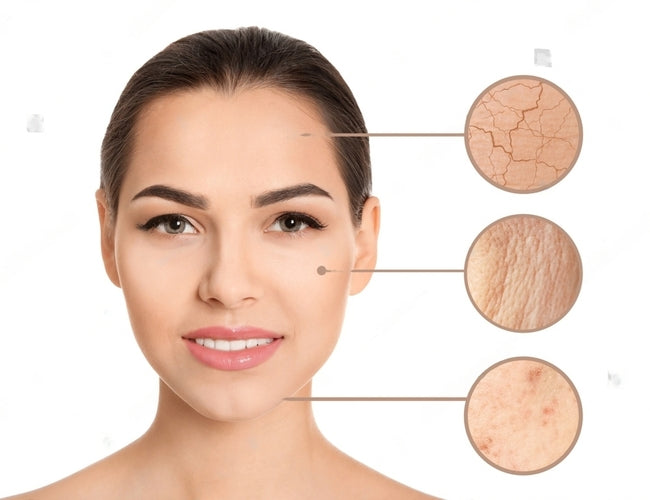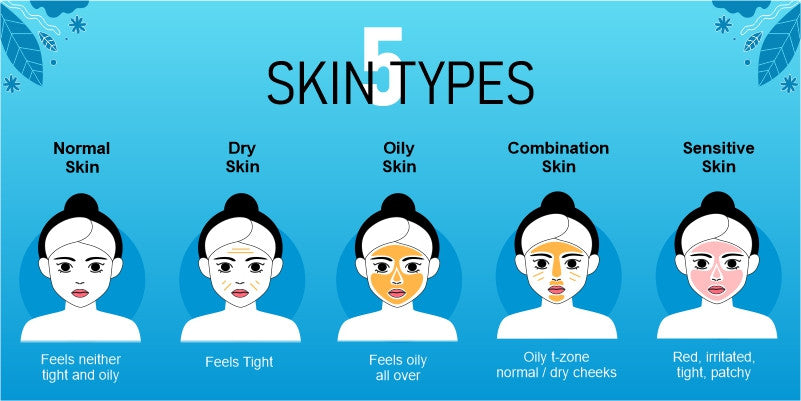How to Do Skincare Based on Skin Types?
1. Understand Skin Types
If you don’t understand your skin type and engage in beauty treatments in this state, no matter how much you try, it may be futile and even harmful to yourself. It’s like a doctor prescribing medication without considering the patient’s condition, and the consequences can be disastrous.
Only by understanding one’s own skin type can one choose the right skincare products and use the correct skincare techniques. Therefore, it is necessary to determine one’s skin type before skincare.
Skin is divided into five types in aesthetics: normal skin, dry skin, oily skin, combination skin and sensitive skin.
2.Normal Skin
2.1 Skin Features
The pores are small, the skin is smooth, and it has a particularly transparent feeling. This skin type is healthy, feels smooth, and has just the right balance of oil and moisture. It’s less prone to acne and blackheads. It doesn’t usually feel oily or tense.
2.2 Skin Advantages
Normal skin is the most ideal skin type, usually possessed by children before puberty. After adolescence, a small number of adults are still fortunate enough to retain their normal skin.
2.3 Skin Troubles
The T-zone is slightly greasy in summer and slightly dry in winter. The perfect state is easily overlooked and neglected, and with age, it can quickly transform into dry skin.
2.4 Maintenance Focus
This type of skin only needs to be maintained daily, moisturized more, and don’t forget to use sunscreen.
3. Oily Skin
3.1 Skin Features
The pores on many parts of the face are very large, always oily and looking a bit rough. After washing the face, we won’t feel tight, but after two or three hours, we’ll start to feel oily again. It is also prone to blackheads and pimples, all because the sebaceous glands in the skin are too active and secrete too much oil. Especially during adolescence and in boys, the skin is prone to oiliness. When staying up late or under high pressure, the skin is also prone to oiling.
3.2 Skin Advantages
Oily skin produces more oil, and the skin has a natural moisturizing barrier that helps the upper layer of skin retain moisture and protect it from dry factors in the environment, making it less prone to dry lines and fine lines. So oily skin is fuller and less aging compared to other skin types.
3.3 Skin Troubles
Oily skin usually has a glossy appearance and a feeling of greasiness and uncleanliness. Excess oil can easily adsorb dead skin and dirt, causing clogged pores and leading to problems such as blackheads, pimples, and acne. Meanwhile, oily skin is prone to shedding makeup. In addition, with age, the internal moisturizing factors of the skin are lost, and oily skin needs refreshing moisturizing.
3.4 Maintenance Focus
In addition to daily facial cleaning, don’t forget to exfoliate and apply facial mask. At the same time, facial mask and toner are also very important for deep cleaning and pore convergence. They can not only remove oil, but also inhibit oil. Regular maintenance should pay attention to the function of controlling oil while refreshing and moisturizing.

4. Dry Skin
4.1 Skin Features
The pores are small and almost invisible, and the surface of the skin does not shine with oil, presenting a matte state. Easy to form fine dry lines and expression lines, especially around the eyes and lips. Dry skin is prone to tightness and even peeling. After cleansing, there is usually a prolonged feeling of tightness. People living in hot or cold low humidity climates are more likely to have dry skin.
4.2 Skin Advantages
Dry skin has delicate texture due to small pores. Less oil production, less likely to adsorb dirt, less likely to have a feeling of uncleanliness, and less likely to have problems with clogged pores and blackheads. Moreover, dry skin is not easy to remove makeup after applying it. If dry skin is taken care of early, the skin will look delicate and clean.
4.3 Skin Troubles
Dry skin is prone to tightness, lacks luster, and is prone to peeling or cracking. Due to prolonged dehydration, dry skin is more prone to dry lines and fine lines compared to other skin types, making it more prone to sagging and aging. The stratum corneum of dry skin is relatively thin, making it easily irritated, sensitive, and prone to pigmentation.
4.4 Maintenance Focus
Dry skin requires attention to moisturizing and nourishing every step from cleansing to maintenance. At the same time, dry skin is delicate, so it is important to choose gentle skincare products. Be careful not to excessively exfoliate dry skin. Strengthen sun protection throughout the year to avoid small spots and photoaging. Paired with massage, it can promote blood circulation, nutrient delivery, and enhance metabolism.
5.Combination Skin
5.1 Skin Features
This is the most common skin type. Because after adolescence, most people’s skin looks healthy and has a smooth texture, with only the T-zone being slightly greasy, while the cheeks are not too greasy or even tight. There are two types of combination skin, which usually change with the seasons. For example, in summer, the mixture tends to be oily, but in winter, it tends to be dry.
Combination-dry skin refers to skin with oily T-zone in the middle, enlarged pores, but dry cheeks and a tight feeling, usually with dry lines around the eyes. Combination-oily skin refers to a skin type where the middle T-zone is relatively oily, with enlarged pores, but there is not much oil on the cheeks, nor is it tight, and it feels relatively comfortable.
5.2 Skin Advantages
Combination skin is neither too oily nor too dry.
5.3 Skin Troubles
The T-zone of this skin and the troubles on both cheeks are different, sometimes even opposing needs. Skin is prone to problems such as acne and pimples.
5.4 Maintenance Focus
Need to balance the maintenance needs of the T-zone and cheeks, or differentiate care. Attention should also be paid to cleaning pores and preventing acne for combination skin. This skin in spring and summer is prone to greasiness, so it is necessary to keep the skin fresh and tighten pores. In autumn and winter, it is recommended to strengthen moisturizing and moisturization.
6. Sensitive Skin
Sensitive skin is a type of problematic skin that can exist in any skin type. Just like all skin types may have aging skin, acne skin, and so on.
6.1 Skin Features
The skin is thin, with obvious red blood streaks (vasodilation). Easy to turn red. When the weather changes and it gets too cold or too hot, the skin is prone to redness and fever. This type of skin is easily influenced by environment, season, and skincare products, and may be innate or have sensitive skin throughout the body.
6.2 Skin Troubles
It is easy to turn red, heat up, itch, and sting when stimulated, and in severe cases, it can also cause redness, swelling, or rash. The skin tone is also uneven, and once inflammation subsides, it is easy to leave marks or spots.
6.3 Maintenance Focus
Pay attention to basic maintenance such as moisturizing. Increasing skin moisture content and strengthening skin barrier function can greatly enhance skin resistance and reduce the stimulation of external substances on the skin. Choose gentle and suitable skincare products, and do not replace them frequently. Avoid using any skincare products that may irritate the skin and pay attention to sun protection. Be careful when choosing intensive care (essence, facial mask). Test a new product before using it. Pay attention to gradually increasing the dosage from small to large. Sensitive skin has thin keratin, so exfoliating products should be used with caution and the gentlest exfoliating method should be chosen.






